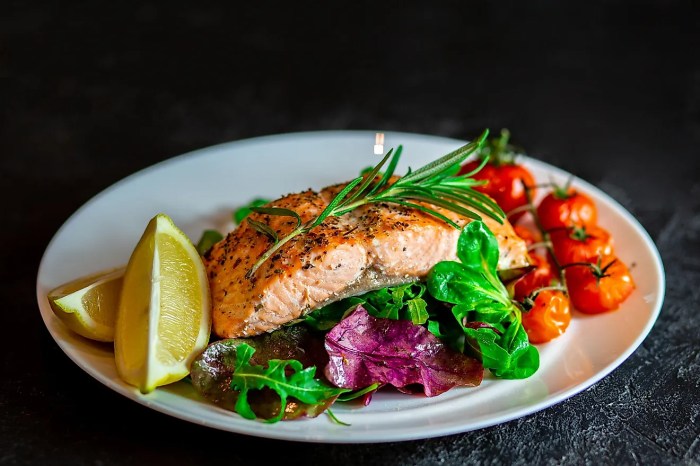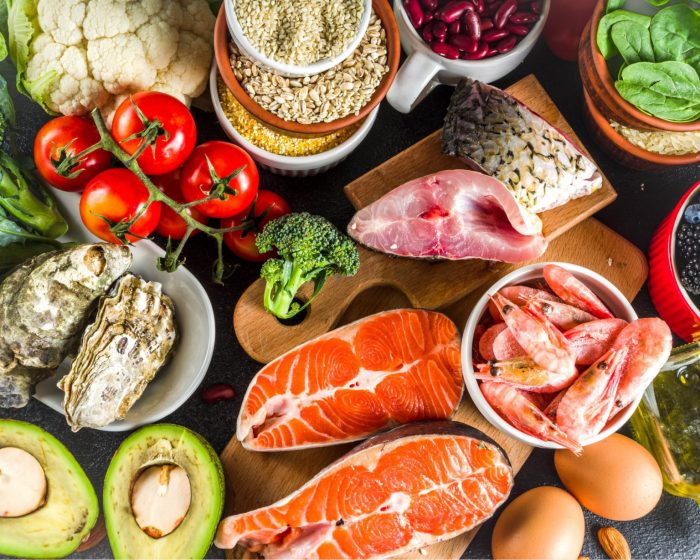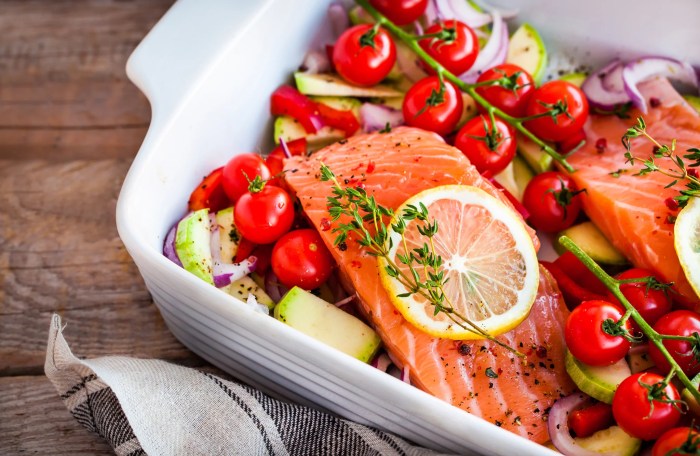Going pescatarian, a dietary approach that embraces seafood while excluding other animal meats, is gaining popularity for its potential health, ethical, and environmental benefits. This comprehensive guide delves into the intricacies of this unique eating pattern, providing insights into its principles, motivations, challenges, and adaptations.
From understanding the fundamental principles to navigating social situations and ensuring nutritional adequacy, this guide empowers you to make informed choices about adopting a pescatarian lifestyle. Join us as we explore the world of pescatarianism, uncovering its nuances and inspiring you to embrace a more sustainable and fulfilling way of eating.
Definition and Overview

Going pescatarian is a dietary approach that excludes meat and poultry but allows the consumption of fish and other seafood. Pescatarians follow a primarily plant-based diet, with a focus on fruits, vegetables, whole grains, and legumes.
Dietary Restrictions
A pescatarian diet excludes all meat from land animals, including beef, pork, lamb, and chicken. It also prohibits poultry, such as turkey and duck. However, pescatarians can consume fish, shellfish, and other seafood, making it a more flexible vegetarian diet.
Potential Health Benefits
Following a pescatarian diet has been associated with several potential health benefits, including:
- Reduced risk of heart disease
- Lower blood pressure
- Improved cholesterol levels
- Reduced risk of stroke
- Improved brain health
Potential Risks
While a pescatarian diet can be healthy, there are some potential risks to consider:
- Deficiency in vitamin B12, which is found primarily in animal products
- Inadequate intake of iron and zinc, which are less well-absorbed from plant sources
- Contamination of fish with mercury and other toxins
Motivations for Going Pescatarian
The decision to adopt a pescatarian diet is influenced by a myriad of factors, encompassing ethical concerns, environmental consciousness, and health considerations. Furthermore, cultural and personal values play a significant role in shaping this dietary choice.
Ethical Motivations
- Compassion for animals:Pescatarians often choose to exclude meat from their diet due to ethical concerns regarding the treatment of animals in factory farming systems. They believe that animals deserve to be treated with respect and compassion, and that consuming their flesh is unnecessary.
- Overfishing and marine conservation:The fishing industry has a significant impact on marine ecosystems, leading to overfishing and the depletion of fish populations. Pescatarians may choose to limit their consumption of fish to support sustainable fishing practices and protect marine biodiversity.
Environmental Motivations
- Greenhouse gas emissions:Animal agriculture is a major contributor to greenhouse gas emissions, particularly methane and nitrous oxide. By reducing meat consumption, pescatarians can help mitigate their environmental impact.
- Water conservation:Meat production requires a significant amount of water, while fish farming is generally more water-efficient. Pescatarians can conserve water resources by choosing to eat more fish and less meat.
Health-Related Motivations
- Reduced risk of chronic diseases:A pescatarian diet is rich in omega-3 fatty acids, which have been linked to a reduced risk of heart disease, stroke, and some types of cancer. Additionally, fish is a good source of protein, iodine, and vitamin D.
- Weight management:Fish is generally lower in calories and fat than meat, making it a good choice for weight management. Pescatarians may also benefit from increased satiety due to the higher protein content of fish.
Cultural and Personal Values
- Religious beliefs:Some religions, such as Buddhism and Hinduism, promote vegetarianism or pescatarianism as a way to align with principles of non-violence and compassion.
- Personal preferences:Ultimately, the decision to become pescatarian is a personal one, often influenced by individual tastes, beliefs, and lifestyle choices.
Food Sources and Meal Planning
Embracing a pescatarian diet necessitates a comprehensive understanding of the diverse food sources that align with its principles. This encompasses not only seafood but also an array of plant-based proteins and whole grains, ensuring a balanced and nutritious dietary intake.
Seafood, the cornerstone of a pescatarian diet, provides a rich source of omega-3 fatty acids, essential for heart and brain health. Fatty fish, such as salmon, tuna, and mackerel, are particularly abundant in these beneficial fats. Other seafood options include lean fish like cod, tilapia, and flounder, as well as shellfish like shrimp, mussels, and oysters.
Plant-based proteins play a crucial role in complementing seafood intake. Legumes, such as beans, lentils, and chickpeas, are excellent sources of protein and fiber. Tofu and tempeh, made from soybeans, offer versatile plant-based protein options. Nuts and seeds, including almonds, walnuts, and chia seeds, provide additional protein and healthy fats.
Whole grains, such as brown rice, quinoa, and whole-wheat bread, serve as a foundation for a pescatarian diet. They provide complex carbohydrates, fiber, and essential vitamins and minerals. Fruits and vegetables, rich in antioxidants and vitamins, complete the pescatarian dietary spectrum, ensuring a well-rounded nutritional profile.
Meal Planning for Pescatarians, Going pescatarian
Meal planning for pescatarians involves striking a balance between seafood, plant-based proteins, and whole grains. Aiming for at least two servings of seafood per week is recommended, with a focus on fatty fish. Plant-based proteins should be incorporated into meals regularly, either as the primary protein source or as a complement to seafood.
Whole grains should form the base of most meals, providing sustained energy and essential nutrients.
To ensure adequate protein intake, consider combining plant-based proteins in meals. For example, a lentil soup with whole-wheat bread or a tofu stir-fry with brown rice provide a complete protein profile. Including a variety of seafood, plant-based proteins, and whole grains throughout the week ensures a balanced and nutritious pescatarian diet.
Sample Meal Plans and Recipes
Here are sample meal plans and recipes to demonstrate the variety and flexibility of a pescatarian diet:
- Breakfast:Oatmeal with berries and nuts; whole-wheat toast with avocado and smoked salmon
- Lunch:Grilled salmon salad with mixed greens, quinoa, and vegetables; lentil soup with whole-wheat bread
- Dinner:Pan-seared tuna with roasted vegetables and brown rice; tofu stir-fry with whole-wheat noodles
These examples showcase the diverse range of pescatarian-friendly options, ensuring a satisfying and nutritious dietary experience.
Challenges and Adaptations
Embracing a pescatarian diet brings forth certain challenges, but with careful planning and mindful adaptations, these hurdles can be effortlessly overcome. From social gatherings to dining out dilemmas, this guide provides practical strategies to navigate these situations seamlessly.
One potential obstacle lies in social situations where meat-centric dishes are prevalent. To address this, it’s advisable to offer to bring a pescatarian-friendly dish to share, ensuring you have a satisfying and inclusive dining experience. When dining out, research restaurants beforehand to identify those that cater to pescatarian preferences.
Many establishments now offer diverse menu options, making it easier to find suitable choices.
Nutrient Considerations
Maintaining a balanced pescatarian diet requires attention to nutrient intake. Omega-3 fatty acids, commonly found in oily fish, are crucial for overall health. To ensure adequate intake, incorporate fish into your meals at least twice a week. Plant-based sources of omega-3s, such as flaxseeds and walnuts, can also be included.
Vitamin B12, primarily obtained from animal products, is essential for neurological function. Pescatarians can obtain this nutrient from fish, shellfish, and fortified foods like nutritional yeast or plant-based milks.
Dietary Adaptations
Pescatarians can adapt their diet to accommodate specific dietary needs or preferences. For those with allergies or intolerances, it’s important to carefully review ingredient lists and avoid potential allergens. Cultural traditions can also influence dietary choices. Pescatarians can explore plant-based alternatives to traditional meat dishes, such as tofu or tempeh, to maintain cultural connections while adhering to their dietary preferences.
Related Topics

Pescatarianism shares similarities and distinctions with other dietary patterns. It also has implications for environmental sustainability and offers resources for support.
Pescatarianism and Other Dietary Patterns
Pescatarianism falls under the umbrella of semi-vegetarian diets, along with vegetarianism and veganism. Vegetarians abstain from all animal flesh, including seafood, while vegans exclude all animal products, including dairy, eggs, and honey. Flexitarianism is another semi-vegetarian approach that allows for occasional consumption of meat or poultry.
If you’re considering adopting a vegetarian diet, it’s important to ensure you’re getting all the nutrients your body needs. A well-balanced vegetarian diet list should include a variety of plant-based foods, including fruits, vegetables, legumes, and whole grains.
Pescatarianism and the Environment
Seafood consumption has a significant environmental impact. Overfishing, habitat destruction, and pollution pose threats to marine ecosystems. By reducing meat consumption and choosing sustainable seafood options, pescatarians can contribute to ocean conservation.
Embark on a journey towards healthier eating with a vegetarian diet list. Embrace the power of plant-based nutrition to fuel your body and nourish your soul. From leafy greens to legumes and whole grains, this comprehensive guide provides an array of options to support your dietary needs.
Organizations Supporting Pescatarians
Several organizations provide resources and support for pescatarians, including:
- The Pescatarian Society: Offers information, recipes, and community support.
- Seafood Watch: Provides ratings and recommendations for sustainable seafood choices.
- The Humane Society: Advocates for animal welfare and promotes plant-based diets.
Last Recap

The pescatarian diet, with its emphasis on seafood and plant-based foods, offers a balanced and sustainable approach to nutrition. Whether driven by ethical concerns, environmental consciousness, or health aspirations, going pescatarian can be a transformative journey. By embracing this dietary shift, you not only nourish your body but also contribute to a healthier planet.
Remember, every meal is an opportunity to make a positive choice, and the pescatarian path is an invitation to explore a world of culinary delights while honoring your values.
Answers to Common Questions: Going Pescatarian
What are the key principles of a pescatarian diet?
Pescatarians consume seafood, including fish, shellfish, and crustaceans, while excluding all other animal meats, such as poultry, beef, and pork.
What are the potential health benefits of a pescatarian diet?
Pescatarians may have a lower risk of heart disease, stroke, and certain types of cancer due to the high intake of omega-3 fatty acids and other nutrients found in seafood.
How do I ensure I’m getting enough protein on a pescatarian diet?
In addition to seafood, pescatarians can obtain protein from plant-based sources such as beans, lentils, tofu, and tempeh.
What are some challenges of going pescatarian?
Social situations and dining out can pose challenges for pescatarians, but with planning and preparation, it’s possible to navigate these situations successfully.